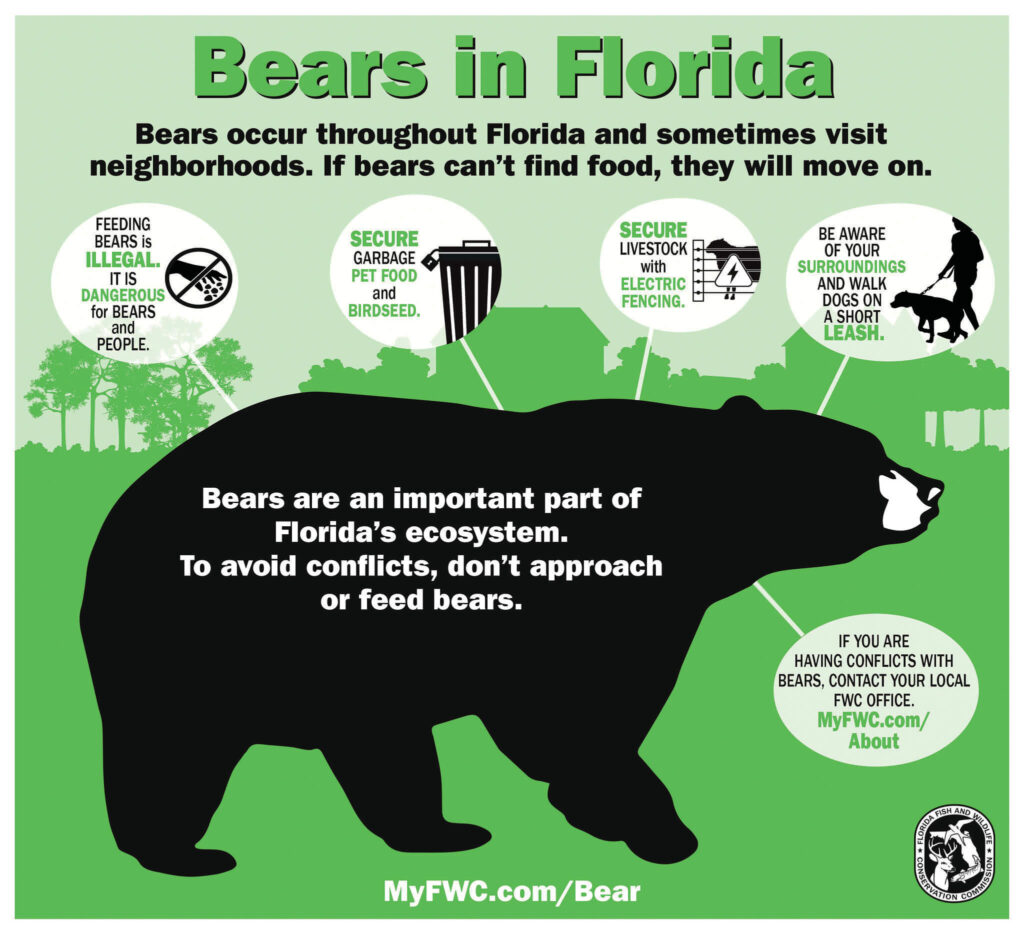By BLANCHE HARDY, PG

It’s bear season.
Florida’s black bears are prepping for winter and although Florida’s forested areas offer abundant food for hungry hibernation-preparing bears, they frequently feed in residential areas where food is high in calories and easy to obtain.
The Florida Fish and Wildlife Conservation Commission (FWC) has a saying everyone should learn, “A Fed Bear is a Dead Bear.”
Bears eat about 5,000 calories a day, except in the fall when they are preparing for winter.
“Adult bears need to take in about 20,000 calories/day during the fall,” FWC’s Bear Management Program Coordinator, David Telesco reports. “If given the opportunity, bears will take advantage of easy meals, everything from unsecured trash cans to bird feeders. However, if bears don’t find a food source in a neighborhood, they’ll move on.”
Florida’s bears are smart enough to forgo the 18 hours/day needed to forage in favor of feeding from residential garbage cans, bird feeders, and gardens.
Bears also are very good climbers and will feed individually or in family groups in nut-bearing trees.
In the Rock Springs Ridge subdivision in Apopka, a frequent bear stomping ground, a group of bears recently spent a week or so munching their way through this year’s bumper crop of acorns in the neighborhood’s front yard oak trees.
Used to such visits, the residents simply report the presence of the bears and neighbors ignore the bears until they leave and then clean up the acorn debris. This meets FWC’s rule number one, “Never feed or approach bears.”

Feeding a bear may result in the animal losing their fear of people which rarely ends well for the bear. It is also illegal to intentionally feed or leave food out for bears. No matter how fluffy and cute that juvenile bear is, it is a wild animal with nasty, dangerous claws and teeth.
Garbage cans in bear-prone areas should be kept in the garage or in a sturdy out-building until the morning of pick-up. If no suitable storage area is available, bear-resistant containers or a modified bear-resistant garbage can should be used.
Likewise, bird feeders and pet food containers represent snack time for bears. Bird feeders should only contain a day’s worth of food or should be brought in at night and returned outside during the day. Pets should be fed indoors. Household pets are no match for a bear.

Personally, I have received resident complaints where homeowners thought the bears eating out of their bird feeder were so cute, until the bear broke the fence or threatened one of their pets.
Dogs can trigger bears into a defensive stance.
According to the FWC, 60% of incidents where people were injured by a bear involved dogs. In areas where wild animals are present it is best to keep your dog on a fixed leash. Be alert. Make sure to turn on your outside lights when letting your pets out at night. If you are in a bear or wildlife prone area, make some noise such as banging the door or banging on a pot with a spoon to warn wildlife to move away from your area.

Bears are smart. Sierra Club recently released “Does a Bear Think in the Woods” including the details of a long-observed bear family whose matriarch, Squirty, was rescued as a cub and released into the wild. Like an increasing number of studies observing animal behavior, observation of Squirty’s clan more than 20 years rendered surprising results about the cognitive capabilities of bears.
The observations indicate bears are social; they have a society, in this case a matriarchy governed by Squirty; they use a rich system of communication; they are highly self-aware; and they are governed by long-term relationships and rules of conduct.
Enjoy the bears and keep them safe. They are very entertaining . . . from a distance.●













































